Real-life customer experience examples serve as a vivid illustration of what’s important in business. After all, how the experience makes the customers feel will determine how they remember your business.
89% of US consumers are willing to move to a competitor due to bad customer experience (CX). One of the main reasons behind losing customers is not the price or quality of the product, but poor customer service. (Qminder)
The quality of the customer journey is what differentiates companies from the competition.. Customer experience experts continue to stress the importance of customer-centric company operations. Poor customer service can hurt a business. Yet, implementing a successful customer service strategy often presents challenges.
Blake Morgan is a customer experience futurist. She says some businesses struggle with CX strategy and collaboration efforts.
What is the most pressing customer experience challenge your company faces?
— Blake Morgan (@BlakeMichelleM) March 6, 2023
So, how can companies do it right? Looking at outstanding customer experience examples can help. It’s important to note why a specific strategy works. In some cases, companies base certain tactics on psychological principles. They fuel better customer service. In others, a company-wide initiative amplifies a strategy that works on a smaller scale. Whatever the basis for a successful CX strategy, examining it and applying it to a business can help create a memorable customer experience.
What is Customer Experience?
Customer experience (CX) is the overall perception customers have of a brand based on their interactions throughout the entire customer journey, from initial contact to post-purchase support. It includes:
- Customer-Centric Focus: Putting customer needs and preferences first.
- Consistency Across Channels: Ensuring a seamless experience across online, in-store, and customer support interactions.
- Personalization: Tailoring interactions to each customer’s needs.
- Ease and Convenience: Making the experience smooth and hassle-free.
- Feedback and Responsiveness: Listening to and acting on customer input.
- Emotional Connection: Building strong relationships that foster loyalty.
In short, CX is about creating positive, consistent interactions that meet customer expectations, driving satisfaction and brand loyalty.
Why is customer experience important?
Customer experience (CX) is vital because it:
- Builds Loyalty: Positive experiences encourage customers to return.
- Boosts Reputation: Satisfied customers promote the brand.
- Increases Revenue: Loyal customers spend more and drive profitability.
- Differentiates from Competitors: CX sets brands apart in a crowded market.
- Reduces Churn: Meeting customer needs keeps them from switching.
In essence, strong CX drives loyalty, reputation, and growth, making it essential for business success.
12 Best Customer Experience Examples
As with any aspect of business – and life – the only thing that is constant is change. A great customer experience strategy involves following evolving customer experience trends. Technological innovations and subsequent rising customer expectations serve as guidelines for digital customer experience.
Customer feedback, omnichannel options, personalization, and trust go hand in hand with creating better customer experiences. Here are companies that get it right, showcasing a commitment to customer success. By doing so, they stay above the competition and serve as outstanding customer experience examples for other companies.
1. Amazon: Making it Easy
Without a doubt, Amazon leads in customer experience. It is the largest online retailer in the world, but it’s not its products that win customers. It’s its customer-centric service. It’s quick, efficient, and personalized. It provides customers with options. Be it returns, easy-to-contact customer service, or the customers’ ability to make purchases with just a few clicks, ease of service is key for exceptional CX at Amazon.
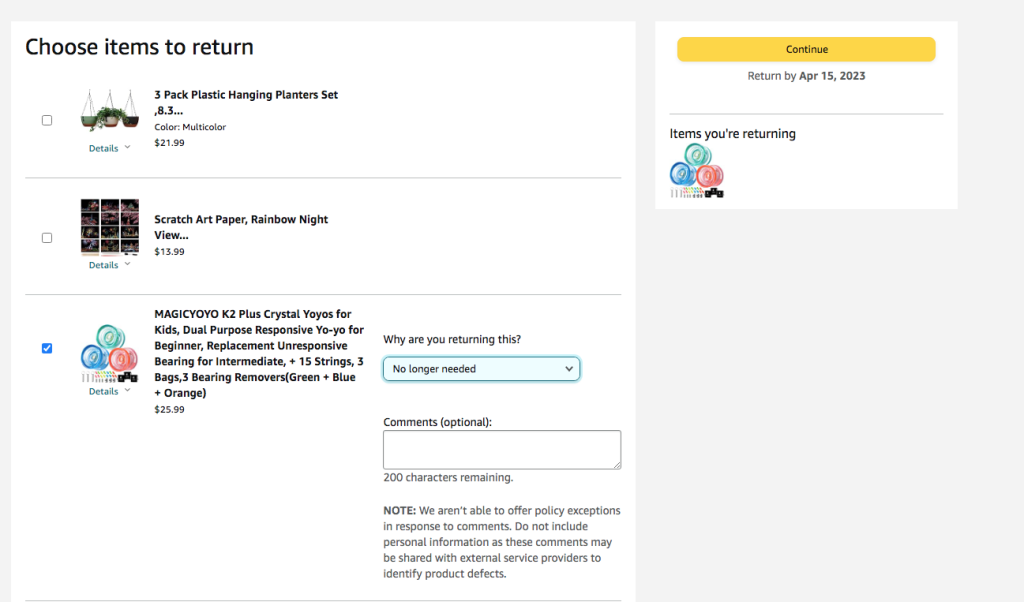
2. Dutch Bros: Friends + Coffee = Happiness
One drawback to living on the East Coast in the U.S. is the lack of Dutch Bros Coffee locations. A west-coast coffee company, in existence since 1992, Dutch Bros prides itself on being “in the relationship business.” Customers couldn’t agree more. The open, genuine, personal service this coffee chain house provides is hard to beat. It’s a great example of a company gaining customer trust through personal service. There is definitely no lack of positive customer reviews for Dutch Bros. Bonus: the company responds to every review, positive or negative. It’s also a great customer experience example to demonstrate how happy customers turn into brand advocates (like yours truly.)
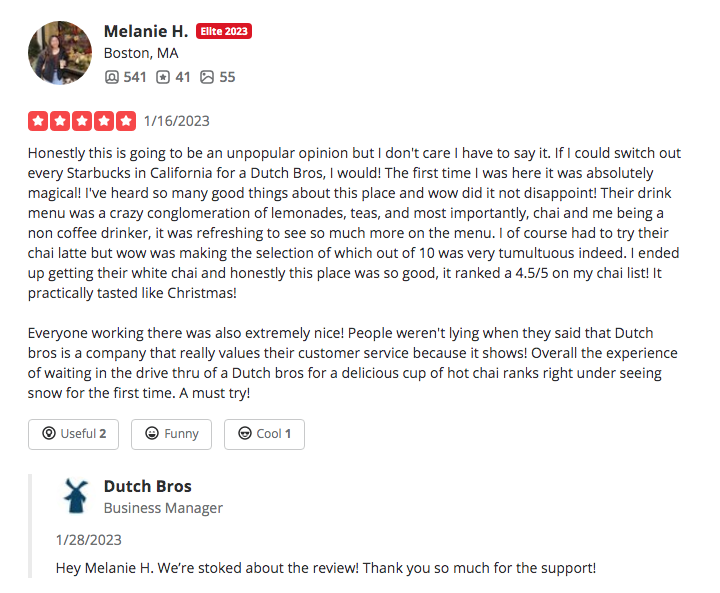
3. Disney: Guestology as Common Purpose
The entertainment enterprise takes its customer experience so seriously, it created an entire institution around it. The Disney Institute teaches the art of customer experience. Its model works so well, we could write a whole post on the topic and, in fact, we did.
Related Post: Read more about Disney Magic of No Worries
The company creates literal magic with the combination of knowing its customers and sharing a common purpose company-wide. Its attention to detail and extensive customer experience training result in world-renown customer service.
4. Trader Joe’s: Employee Experience Fuels Customer Experience
As one expert put it, “Trader Joe’s wants to look like a homey, lovable small business.” Frankly, it does it well. The store employs psychological strategies, intriguing product names, and affordable prices. But more notably, its employees, dressed in Hawaiian shirts, look like they are always having fun. That is because they do. Trader Joe’s rates one of the best places to work. It presents a great example of a positive employee experience turning into a positive customer experience.
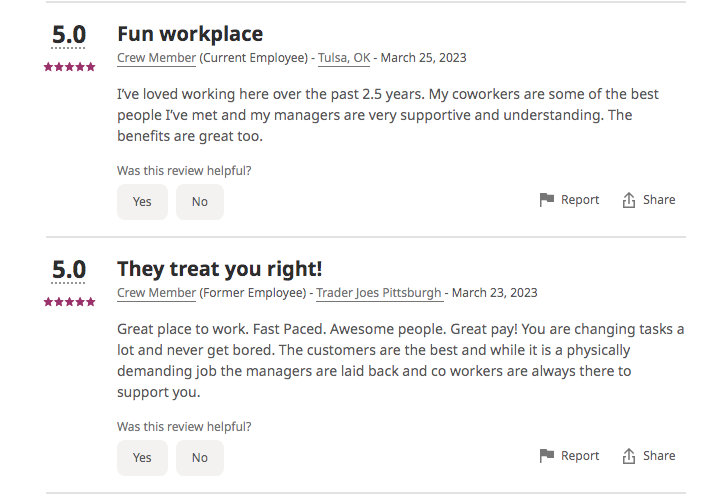
5. Chewy: Small Things are the Big Things
Customers that have an emotional relationship with a brand have a 306% higher lifetime value and will recommend the company at a rate of 71%, rather than the average rate of 45% (Motista).
There is no better way to connect to customers than through their pets. And while there are a ton of pet-focused companies, Chewy’s service is hard to beat. The company focuses on small details – such as surprising customers with handwritten cards and custom pet portraits. Chewy creates an emotional connection with its customers. All for the purpose of creating long-lasting relationships.
6. Spotify: Employing AI to Boost Personalization
As mentioned, tech innovations play a crucial role in customer experience. And especially so, in digital customer experience. In the case of Spotify, artificial intelligence technology works well to create an incredibly personal customer experience. AI allows companies like Spotify to intuitively deliver personalized suggestions to consumers based on their behavior and preferences. In doing so, on a psychological level, it makes the customer think of the company as a friend.

7. Coca-Cola: The Cocktail Party Effect at Work
Another excellent customer experience example, Coca-Cola showcases the power of personalization. #ShareaCoke campaign the company launched in 2011, starting in Australia and then spreading globally.
The moment Lucie Austin saw her name on a Coke bottle, she knew her team had a hit on its hands. “My reaction was childlike,” she recalls. “I knew many others would have the same reaction.” (Project Connect)
Seeing one’s own name is a great example of the “cocktail party effect.” That is one of the psychological principles that fuel customer experience. It explores the human need for personal relevance in their interactions.

8. Fetch: Gamification in Effect
Fetch is an app that rewards customers for everything they buy, anywhere they shop. That includes grocery stores, gas stations, and restaurants. For every photograph of a receipt, the app awards points. The customers can later convert the points into gift cards from various vendors. Entertaining cartoons and extra points for specific featured products add to the fun experience. The app is a great example of gamification as a customer experience strategy.
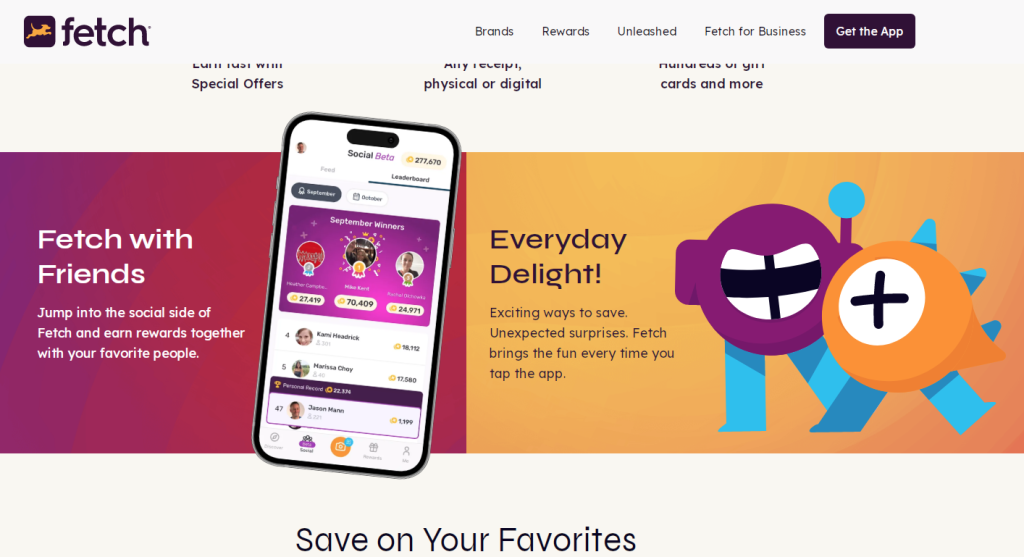
9. JetBlue: Omnichannel Customer Service
JetBlue delivers omnichannel customer support. The brand offers phone and email support, a searchable knowledge base, and live chat technology. It provides SMS updates and a smartphone app offer communication options to customers. Through it all, the company maintains a human touch.
The company’s social media customer support stays on top of customer communication. Jet Blue representatives respond to comments within minutes. They direct customers to helpful pages and address customer complaints. Representatives interact with users using emojis and GIFs. They keep things light and friendly while giving customers options in terms of ways to communicate their needs.
“JetBlue Airways is dedicated to bringing humanity back to air travel. We strive to make every part of your experience as simple and as pleasant as possible.” (Robin Hayes, CEO, JetBlue Airways)
10. FedEx: Information is Power
FedEx customer experience exemplifies the power of information. Recent texting statistics show that customers appreciate SMS updates, so FedEx cashes in on the trend of connecting with customers via text. The delivery company sends text communications to customers about upcoming packages. It also continuously follows up with customers to resolve issues, provide support, and collect feedback. Such attentive practices help FedEx build its customers’ trust and loyalty. And it provides a competitive advantage among the competition.
Another notable customer experience example FedEx provides is its customer-centric newsletter. It delivers news about services, products, and deals to customers. The streamlined communication makes things better for internal teams and customer engagement. Instead of sending out different emails, each team works together to deliver better results and offerings to the customers. In turn, customers receive relevant information right in their mailboxes.
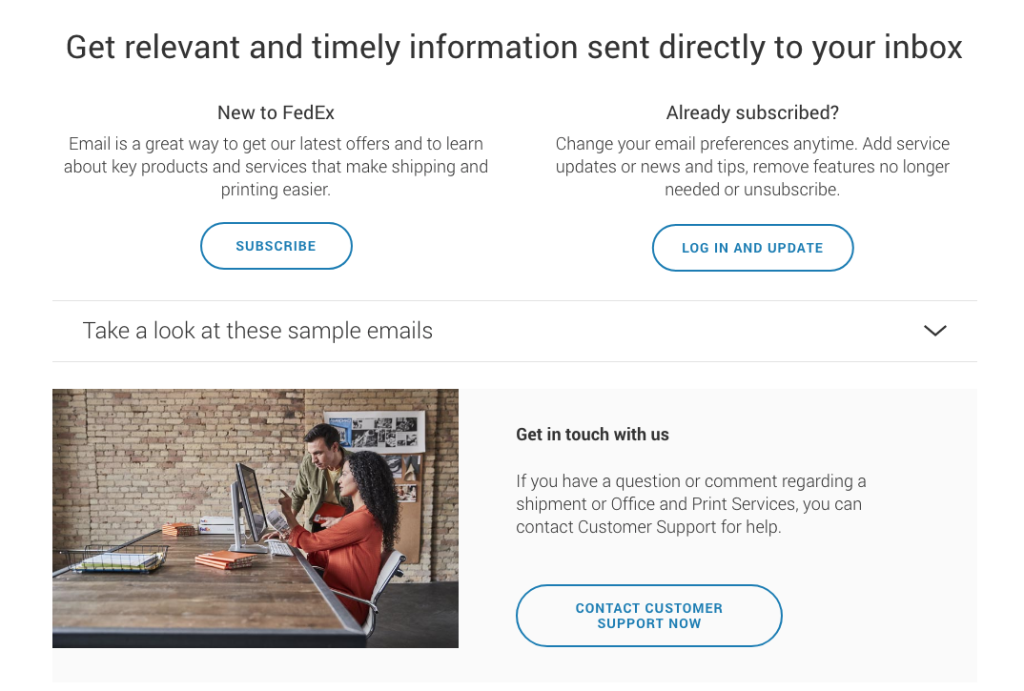
11. UPS: Use of Customer Data Points to Better CX
“UPS harnesses massive amounts of data from throughout its Global Smart Logistics Network to provide our customers with unmatched service. By expanding our use of Google Cloud, UPS can achieve a higher level of predictive data analytical capabilities, improving our customers’ experience and generating operational efficiencies while also helping to reduce our carbon footprint.” (Juan Perez, UPS Chief Information and Engineering Officer)
The company shows that consistently monitoring customer data and using analytical skills brings the ability to better understand and meet customers’ expectations. The company collects and analyzes more than one billion data points. That helps forecast, see, and control how packages move through UPS’s network.
Through its use of Google Cloud, UPS addresses sustainability challenges as well. For example, routing software that leverages Google Cloud’s expertise in data analytics enables UPS to optimize delivery routes and reduce its fuel consumption. (UPS Google Cloud Use)
12. Nike: Listening to Customer Feedback
Listening to customer feedback is one of the most effective ways to create a unique customer experience. For professionals looking to boost their data analysis skills, preparing with Microsoft PL-300 practice tests dumps can also enhance their ability to interpret and act on valuable customer data.
The practice does four notable things:
- Social Proof. Consumers feel better about doing business with a company when they understand the brand. A company that makes it clear and obvious that it cares about its social standing and listens to customers makes customers feel good about their purchasing decisions.
- Builds Trust. As humans, we’re wired to appreciate our own impact in the world. When customer feedback matters to a company, customers are more likely to trust the brand.
- Aids in Decision Making. It’s hard to know where you’re going if you don’t know where you’ve been. Knowing how a company’s practices and decisions sit with the customer base can help make better future decisions to retain customer loyalty and trust.
- Gives Customers a Voice. When customers see a company listening, they feel like their voice matters. They feel empowered. That in itself betters customer experience.
Nike showed how it values its customer feedback when it recalled its Air Max 1 USA shoes that featured the Betsy Ross flag.
Nike said in a statement that “it pulled the shoe based on concerns that it could unintentionally offend and detract from the nation’s patriotic holiday.” The company pushed back against criticism that the decision was “anti-American.” (PBS)
By listening to customer feedback, Nike bet on gaining more trust from its younger, more liberal customers. Even though the move angered some customers, the company demonstrated its willingness to listen. By making the choice to recall the shoe, the brand took a stand on a social issue. Today, customer lifetime value relies on customer satisfaction. That, in turn, depends on the alignment of values between the customer and the brand.
Conclusion: Customer Experience Examples Showcase Valuable Strategies
The customer experience examples above all have something in common: they follow customer preferences and expectations, making it clear that prioritizing the customer is the key to success. They aim to deliver what the customers want, from personalization to seamless interactions, ensuring each experience is memorable and meaningful. This dedication to customer satisfaction is what sets these companies apart as leaders in their industries.
By studying these examples, other businesses can pinpoint effective strategies that elevate the customer experience, identifying why they work and how they resonate with audiences. Similarly, tools like Microsoft PL-300: practice tests dumps help individuals refine their skills and meet certification goals. With these insights, companies can not only meet but exceed customer expectations, continuously refining their approach to provide exceptional service. The takeaway is simple but powerful: putting the customer at the center of every decision not only builds loyalty but fosters a reputation for excellence that stands out in today’s competitive market.
Moreover, exceptional customer experiences do more than retain current customers—they create advocates. When customers feel valued, they’re more likely to share positive experiences, recommend brands to friends and family, and publicly endorse companies online. In today’s digital age, where reviews and word-of-mouth are more impactful than ever, every satisfied customer becomes an ambassador. These examples show how powerful customer-focused strategies can be for expanding brand reach without traditional advertising, driving organic growth fueled by genuine connections.
Ultimately, these companies prove that when brands align their goals with customer needs, they not only fulfill expectations but often surpass them. And as businesses continue to evolve, embracing new technologies and listening closely to customer feedback, they’ll find even more ways to deliver exceptional experiences.




